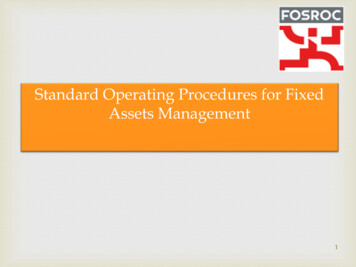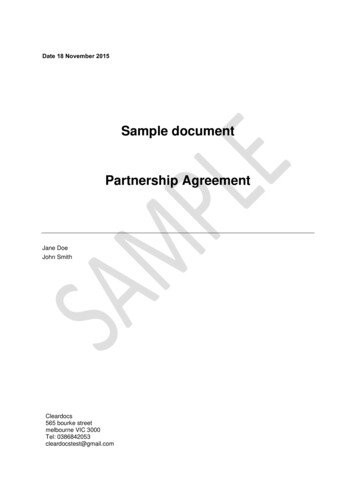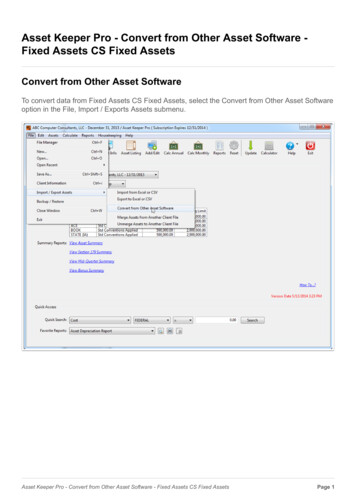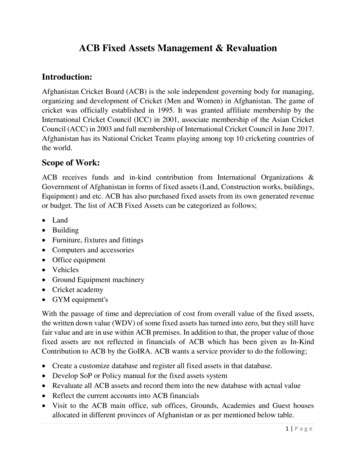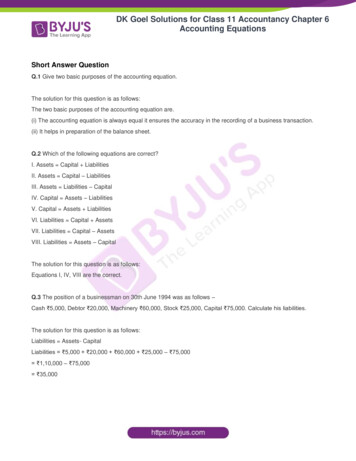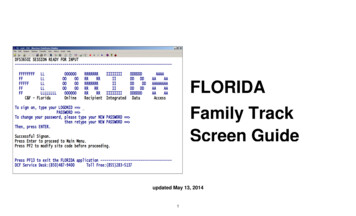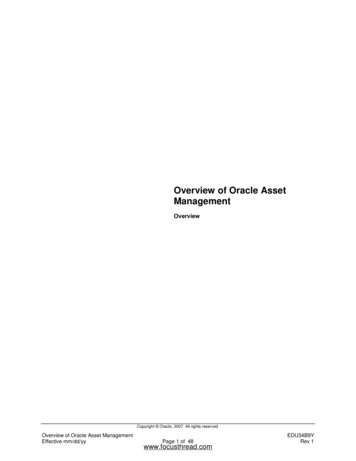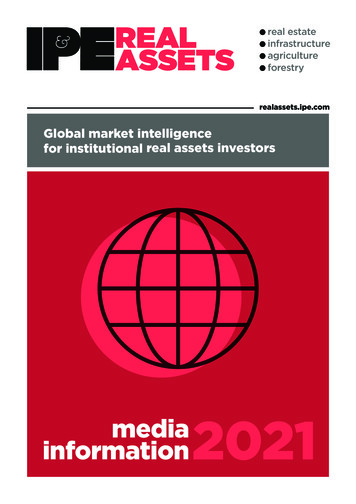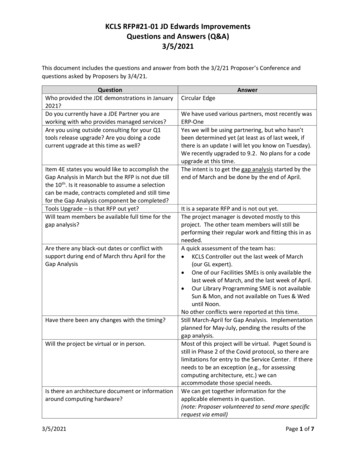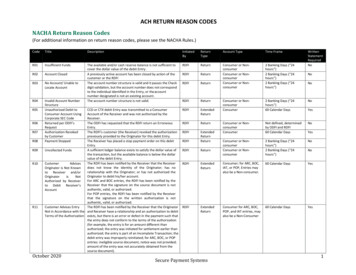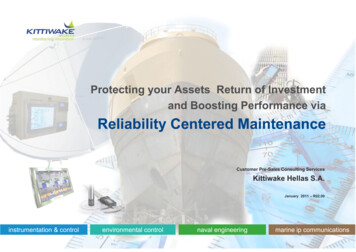
Transcription
Protectingg youryAssets Return of Investmentand Boosting Performance viaReliability Centered MaintenanceCustomer Pre-Sales Consulting ServicesKittiwake Hellas S.A.January 2011 – R02.00instrumentation & controlenvironmental controlnaval engineeringmarine ip communications
What Maintenance Strategy?On-Sight MaintenanceReactive MaintenanceProactive MaintenanceR li bilit CenteredReliabilityC td MaintenanceM i tPredictive MaintenancePreventive MaintenanceMaintenance Preventioninstrumentation & controlenvironmental controlnaval engineeringmarine ip communications
Why Advance Furtherour Maintenance Strategy? PProtect or even iincrease theh return on iinvestments bby iimprovingiassets performance Increase assets lifetime; non compromising performance Decrease expenses Increase predictability on financial performance Reduce downtime duration and frequency Increase customers and shareholders satisfaction Build company culture and corporate quality IncreaseIcompetitivenesstitiinstrumentation & controlenvironmental controlnaval engineeringmarine ip communications
Gain over Total Cost of Ownership115%OpexCapex% vs CorrectiveMedium to LargeSize VesselTCO % vvs "corrective" maint. strgy110%Capex and OOpex105%100%TCO is the “Total Cost ofOwnership” of the asset.95%i.e. the Capex and the Opexover the asset lifetime90%Reactiveinstrumentation & controlenvironmental controlCorrectivePreventivenaval engineeringPredictivemarine ip communications
Gain over Total Cost of Ownership102%OpexCapex% vs CorrectiveVery Large100%Size Vessel98%TCO % vvs "corrective"" maint. strgy96%Capex and Opex94%92%90%88%TCO is the “Total Cost ofOwnership” of the asset.86%84%i.e. the Capex and the Opexover the asset lifetime82%80%Reactiveinstrumentation & controlenvironmental controlCorrectivePreventivenaval engineeringPredictivemarine ip communications
Reducing maintenance costs Cost is not a stand-alone variable It forms an inseparable part of a trilogyRiskPerformanceCostinstrumentation & controlenvironmental controlnaval engineeringmarine ip communications
Preventive Maintenance PPreventivei MMaintenancei(PM) iis theh ffoundationd i off theh entireimaintenance philosophy. PM keyy success contributors are:PM DataPM Data EquipmentSelectedManagementSponsorshipSuccessfulPM programSufficient Detailsin PMinstrumentation & controlRegulationsgComplianceRegularlygyUpdated PMsenvironmental controlWorkforceMaintenanceSkillsnaval engineeringmarine ip communications
Predictive Maintenance PredictivePdi ti maintenancei tiis ththe monitoringit i off equipmentit operatingti conditionsditito detect any signs of wear that is leading to a failure of a component.The goal of the predictive maintenance program is to track the componentwear with a methodology that insures that any impending failure isdetected at its early stages based on key indicators.Within the equipment operating dynamics, we may find the key indicatorsto use:––––––UltrasonicVibration analysisOil analysisLubricant conditionWear particlesetc.instrumentation & controlenvironmental controlnaval engineeringmarine ip communications
Reliability Centered Maintenance Reliability Centered Maintenance (RCM) is an evolutionary approach toequipment reliability. It focusesfon theth optimizationti i ti off theth preventiveti andd predictivedi timaintenance programs to:– increase equipment efficiencyefficiency, as: Uptime Performance Quality– while, minimizing the related maintenance costsinstrumentation & controlenvironmental controlnaval engineeringmarine ip communications
Reliability Centered Maintenance Any RCM process shallAh ll ensure ththatt allll off ththe seven questionstiare answeredd satisfactorilyti f t iland in the sequence shown below:1.What are the functions and associated desired standards of performance of the asset in its presentoperating context (functions)?2.In what ways can it fail to fulfill its functions (functional failures)?3.What causes each functional failure (failure modes)?44.What happens when each failure occurs (failure effects)?5.In what way does each failure matter (failure consequences)?6.What should be done to predict or prevent each functional failure (proactive tasks and task intervals)?77.What should be done if a suitable proactive task cannot be found (default actions)? To answer each of the previous questions “satisfactorily”, the information shall be gathered, andthe decisions shall be made. All information and decisions shall be documented in a way which makes the information and thedecisions fully available and acceptable to the owner of the assetSource: SAE JA1011 "Evaluation Criteria for Reliability-Centered Maintenance (RCM) Processes referencing Message Specificationinstrumentation & controlenvironmental controlnaval engineeringmarine ip communications
Source: USA GAOO FAA RCM Maintenancce ProcessRCM Decision Logicg Treeinstrumentation & controlenvironmental controlnaval engineeringmarine ip communications
Maintenance StrategiesanddEEarlyl FFailureilDDetectiont tiOn-Condition Maintenance Using P-F Interval or Failure Detection Threshold (FDT)On-condition maintenance relies on the capability to detect failures before they happen so that preventive maintenance can be initiated. Many failuremodes exhibit signs of warning as they are about to occuroccur. IfIf, during an inspectioninspection, maintenance personnel can find evidence that the equipment isapproaching the end of its life, then it may be possible to delay the failure, prevent it from happening or replace the equipment at the earliest conveniencerather then allowing the failure to occur and possibly cause severe consequences.P-F curves and P-F IntervalsA common curve that illustrates the behavior of equipment as it approaches failure is the P-F curve. The curve shows that as a failure starts manifesting,th equipmenttheitddeterioratest i t tto ththe pointi t att whichhi h it can possiblyibl bbe ddetectedt t d (P)(P). If ththe ffailureiliis nott ddetectedt t d andd mitigated,iti t d it continuestiuntiltil a "h"hard"d" ffailureiloccurs (F). The time range between P and F, commonly called the P-F interval, is the window of opportunity during which an inspection can possibly detectthe imminent failure and address it. P-F intervals can be measured in any unit associated with the exposure to the stress (running time, cycles, miles, etc).For example, if the P-F Interval is 200 days and the item will fail at 1000 days, the approaching failure begins to be detectable at 800 days.Equipment CondiitionFailure initiatedUltrasonic detectionVibrationVibti ddetectiont tiOil Analysis DetectedAudible NoiseHot to TouchMechanically LooseAncillary DamagePREDICTIVEPREVENTIVERUN TO FAILURECatastrophic FailureTimeinstrumentation & controlenvironmental controlnaval engineeringmarine ip communications
Oil Qualityy Analysisyan Early Warning to Equipment Failure Oil analysisl i fifindingsdiare an earlyl warningi tto equipmentit ffailure,ilandd ffurthermorethprofilefil ththe wearroot causes. To this direction oil analysis should cover the following dimensions:–Solid particle counts –Viscosity –Associated with the remaining useful life of the lubricantFerrous and Non-Ferrous metal level indication –Preferably maintained below the saturation point to avoid additive damage and system corrosionTotal Acid Number (TAN) or in the case of diesel engines, Total Base Number (TBN) –Associated with determining either fluid dilution, incorrect lubricant or as an indicator of the lubricant’s remaining usefullifeMoisture –associated with the root cause of system wear and additive depletionAssociated with the amount of wear metals in the lubricantTemperature Associated with lubricant damage, or incorrect system specification such as alignment problemsinstrumentation & controlenvironmental controlnaval engineeringmarine ip communications
OOn-LineMoonitoringOil Quality Monitoring StrategySample aandOn-SitteAnalysisLinerSCANLinerSCANSample andnd-to-LabSenANALEXAlertANALEXAlertReactive - Correctiveinstrumentation & controlPreventiveenvironmental controlPredictivenaval engineeringmarine ip communications
Next Generation Monitoring Today On-Line Sensors– Data Aggregation– HMI displays and SCADA monitors On-ShipOn-Shore Visibility and Alarm Escalation– On-ship controllers and data aggregation on central operations system (computer)On-Ship Visual Monitoring– What is measured whereCommunication and synchronization with corporate H/QIntegration to the Enterprise Asset Management System–Integration to corporate EAM;based on Asset Management PASS 55 standard (BSI PASS 55:2008)instrumentation & controlenvironmental controlnaval engineeringmarine ip communications
The CompletepPictureOn-ShoreShipping Co.HeadquartersVessel #1VesselCommunicationsGatewayFleet MgrandSuperintendentsVessel rsinstrumentation & controlMCMSSystemenvironmental controlSensorsnaval engineeringmarine ip communications
Kittiwake Hellas yyour end-to-end ppartnerin advancing your PM programme maturity level AAssisti you ini Oil anddLLubricantsbiLLabb analysisl i withi h root causediagnosis Provide yyou with all equipmentq pand trainingg requiredqto insure highgquality Water, Oil, and Lubricants in-depth analysis on-board Upgrade your engines with on-line sensors, for continuousmonitoring of WaterWater, OilOil, and Lubricants Enhance your monitoring quality with supervisory computer-basedvisual workstations on-ship Connect corporate H/Q with IP Satellite communications, enablingintegration to corporate ERP system, Enterprise AssetManagement subsysteminstrumentation & controlenvironmental controlnaval engineeringmarine ip communications
The Kittiwake Sensors Suiteinstrumentation & controlenvironmental controlnaval engineeringmarine ip communications
Kittiwake SensorsLinerSCAN(3/8” BSP)The world’sworld s first real-time alarm system for engine liner wearwear.LinerSCAN marks a new era in asset protection, providingearly warning against critical damage whilst providingOilsightinformation needed to save on lube oil costscosts.glassOil inOil outLinerSCAN measures the amount of iron in cylinder lubricant by amethod known as magnetometry, where a sample is tested in amagnetic field. Utilising a novel shielding method the system exploitsa fundamental physical effect namely the change inductance due tothe presence of a magnetic material.Analyzing the scavenging air space drain oil from each cylinder for iron (Fe) hasbeen proven to give operators an indication of relative changes of cylinder linerwear. At very early stages, the sensors reported the onset of severe wear andother enginegpproblems such as cat fines in the fuel.The system will also highlight periods where the engine is subjected to increased Levelstress levels and indicate changes in iron levels caused by imbedding processes Sensorand increases in wear caused by routine inspection.instrumentation & controlenvironmental controlnaval engineeringAir input(1/2” BSP10Bar max)FerrousMaterialSensormarine ip communications
Kittiwake SensorsWaterSCANWater and oil don’tdon t mix! Even soso, water is the most common contaminant in lube oilsamples and causes a multitude of problems.WaterSCAN provides real time, high accuracy online measurements of total water and soot levels inoil.The presence of water alters both chemical and physical properties of the oil. Changes to viscosity, lubricity, stability andadditives affect the oils ability to lubricate, provide power and protect machinery. This decrease in oil quality can rapidlylead to problems such as rust, corrosion, sludge formation, and bacterial growth. These issues increase downtime,decrease efficiency and ultimately end in critical failure of the plant or machine.Detection Ranges:Water only (clean oils):Accuracy:Soot only (dirty oils):Max water level in dirty oils:F 0.5%For0 5% soott contentt tFor 1.% soot content -instrumentation & control0 – 20,00020 000 ppm,ppm (0 – 2% by volume) /- 2% w/specific oil calibration ( /- 5% by oil type only)0 – 10,000 ppm, (0 – 1% by volume)10,00010000 ppm byb volumel500 ppm by volume.environmental controlnaval engineeringmarine ip communications
Kittiwake SensorsViscoSCANViscosity is the most important property of lubricating oils and is fundamental to providingoptimum film strength with minimum frictional losses. Oil at the correct viscosity willprevent metal-to-metal contact, eliminating scuffing, and reduce microwelding and wear ofmachine surfaces.ViscoSCAN provides real time, high accuracy online measurements of oil’s viscosity. Using a solid statemethod of analysis and a smart module .to calculate and provide graphical results, this sensor can be apart of anyy condition monitoringgpprogram.gcritical informative pDetection Ranges:Absolute Viscosity range:Accuracy:TemperaturepMeasurement Range:gTemperature Accuracy:Outputs:Available outputs:Digital:Analogue:Approvals:instrumentation & control1 – 1000cP /- 2% of reading or /2 2cP whichever is greater-40 to 150ºC /- 1ºCMeasured viscosity in centipoise, Oil temp in CelsiusCAN open, RS-2324 – 20mA X 2CE, ULenvironmental controlnaval engineeringmarine ip communications
Kittiwake SensorsOil Condition SensorThe Oil Condition Sensor goes beyond the normal protection systems; it monitors the root cause oflubricant and machine failure. It puts you in control, by knowing exactly when to change the oil based oncondition, not on historical schedules.This sensor goes beyond the normal hand-held field go/no-go units to offer permanent mounting. Providing both check onwater ingress and oxidation levels, now you can monitor real-time, and take immediate action on the first indication ofchange, before any harm is done to the machine oil.The sensor detects changes caused by water and acid levels, using a combination of proven dielectric sensing, combinedwith smart algorithms to provide a trendtrend.instrumentation & controlenvironmental controlnaval engineeringmarine ip communications
Kittiwake SensorsMoisture SensorThe Moisture sensor goes beyond the normal water screening tests to tell you exactly how dry your oil is.You know that the most severe moisture ingression problem, the greater the potential risk. You canensure that your oil is always below the saturation point before free and emulsified water starts to form.It is known that free and emulsified water cause problems. However most important is the direct increase in the oxidationrate of the lubricant by more than ten times. Bearings could loose 75% of their service life due top water, before the oilbegins to start looking cloudy. Even when dissolved the water is at work, attacking the base stock, the additive package,and the machine itself. Plus, water can carry organisms with it, that could disable your critical hydraulic systemsProviding a % Relative Humidity (RH) and temperature valuesvalues, now you can monitor in real-timereal time.The sensor can be mounted within any lubrication system onany type of machine. Moisture sensors need not be in the fluidto be effectiveeffective. They can be positioned in the headspace of apiece of machinery. The sensor measures the oils percentageRH, resulting from the dissolved water within the lubricant,using a combination of proven thin film capacitance sensors,combined with smart algorithms to provide a temperature and%RH value.You will make informed maintenance planning decisions,whether it is to check the health of your machine, or it is analert of changing moisture ingression rates.instrumentation & controlenvironmental controlnaval engineeringmarine ip communications
Kittiwake SensorsTorque Meter SensorKittiwake s Torque Meter calculates the actual power output of a ship’sKittiwake’sship s propulsion engine, using a contactfree method and without the use of strain gauges; this ensures a quick and easy installation and longproduct life without requiring regular servicing or engineer visits.The system provides: Permanent torque and power display Remote display with 2 X 16 LCD Optional integration with LinerSCAN systemto optimize the cylinder oil feed rate Ethernet or USB interface to a PC for quick calibration Contact-free sensors Simple enough to install, calibrate & maintainwithout factory service Easy to operate Shaft diameter 200 – 1000 mmOther sizes on request.instrumentation & controlenvironmental controlnaval engineeringmarine ip communications
More SensorsSensors To complete the picture of an on-board Integrated Monitoring, Alarm and Control System, it is also required a varietyof more sensors, less specialized categories than those presented in the previous pages.They are:–Temperature sensors – mainly PT100 sensors for the lower temperature range, Thermo Couples for the hightemperature range (200 C and above).–Pressure transducers–RPM sensors–Speed sensors–Hell and trim sensors (inclinometers)–Flow meters–Level meters–Strain gauges–Accelerometers – vibrations, poundinginstrumentation & controlenvironmental controlnaval engineeringmarine ip communications
More Vessel Subsystems beyond the preventive maintenanceBy feeding the on-board Integrated Monitoring, Alarm and ControlSystem, with real-time data from a multitude of on-line sensors, anumber of vessel subsystems or operations can be assisted or evenautomated to a great extend.ypyTypically:–Main engine monitoring, alarm and control–Power ggeneration subsystemymonitoring,g, alarm and control–Fuel efficiency (including bunkering management)–Tank level ggauging,g g, cargog control–Stress and stabilityinstrumentation & controlenvironmental controlnaval engineeringmarine ip communications
Your partner in this businessbusiness We are always prepared to: discuss your needs assist you in planning forward abest practice implementationscheme Size and configure systemalternatives, under fair costapproachKittiwake Hellas S.A.Territorial Agent of Kittiwake Developments UK37, Syngrou Avenue, 117 43 Athens, GreeceT 30 2104227267 F 30 2104227275sales@kittiwakehellas m Be flexible and adaptive to yourown way off managingi your fleetfl tand the new builds operationsinstrumentation & controlenvironmental controlnaval engineeringmarine ip communications
EndThank youyinstrumentation & controlenvironmental controlnaval engineeringmarine ip communications
37, Syngrou Avenue, 117 43 Athens, GreeceT 30 2104227267 F 30 llas.cominstrumentation & controlenvironmental controlnaval engineeringmarine ip communications
Reliability Centered MaintenanceReliability Centered Maintenance Reliability Centered Maintenance (RCM) is an evolutionary approach to equipment reliability. It f thIt focuses on the opti i titimization ofthf the preventive and predi tidictive maintenance programs to: – increase
